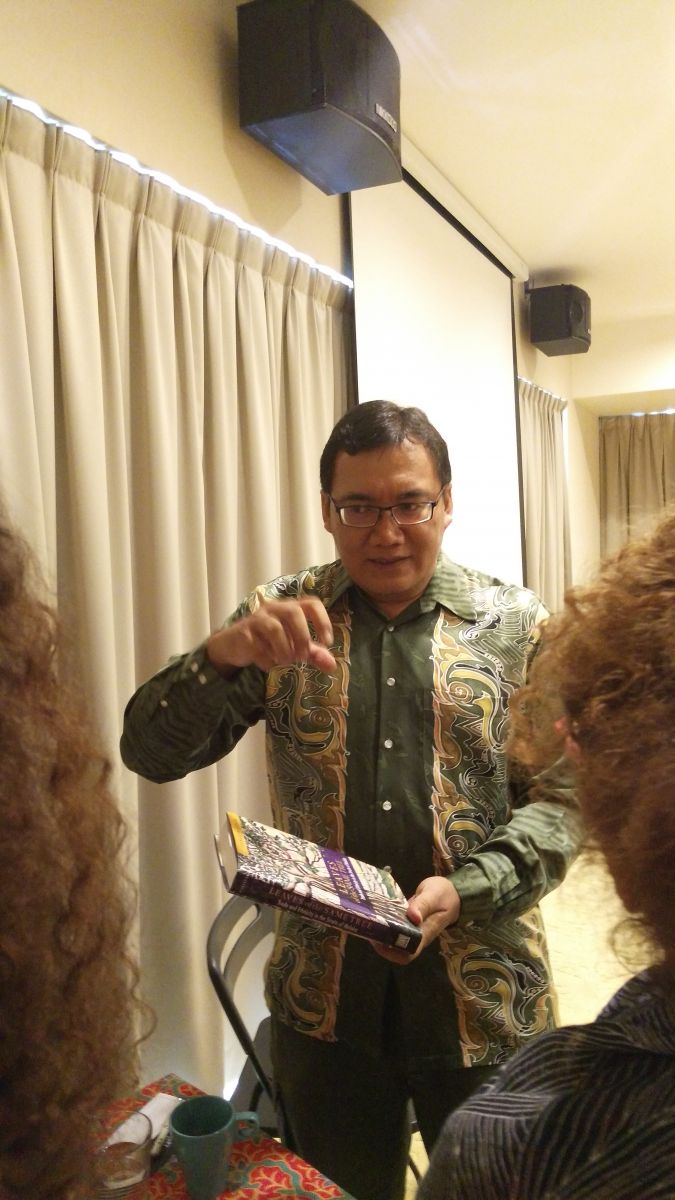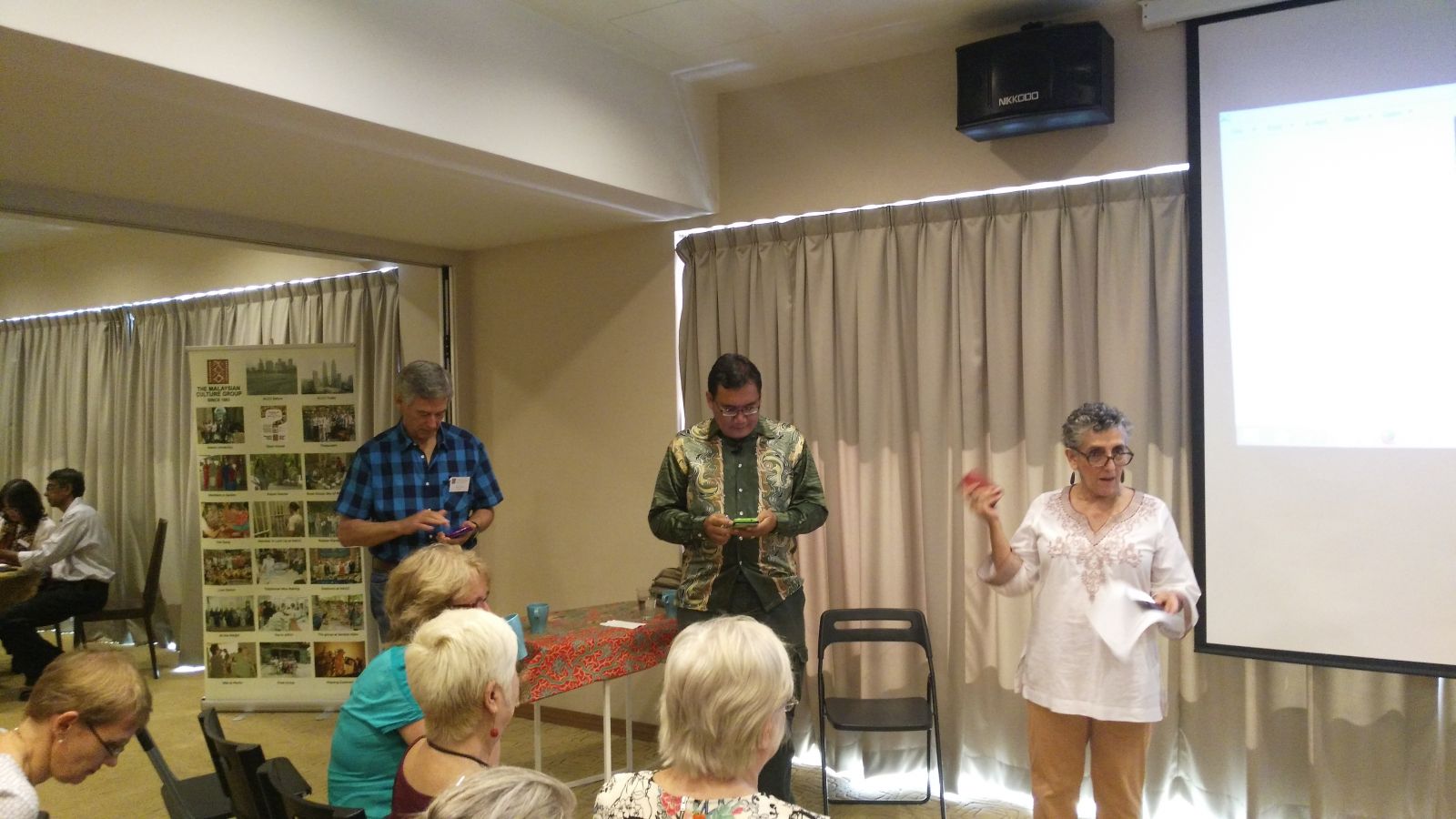 |
“Daulat Tuanku! Daulat Tuanku! Daulat Tuanku!” cries out the Grand Chamberlain at the installation ceremony of Yang di-Pertuan Agong at Istana Negara and the assembly replies three times. Although ‘Long Live the King’ is the traditional translation of this acclamation, Najib Ariffin told the MCG gathering for his talk on the ‘History of the Malay Sultanates’ that it signifies more. Tuanku is translated as ‘my lord’ or king and Daulat, with its roots in Arabic, relates to sovereignty, responsibility and power almost at a supernatural level. The phrase affirms that the people accept the power of the king and that he in return promises to protect his people.
Today nine out of the 13 Malaysian states are still headed by Malay royalty many with long, intertwining histories. At various periods in history all the states comprising Malaysia today were once part of Malay sultanates. The states without sultans are Penang, Malacca, Sarawak and Sabah. The status of Malacca today is ironic as it was once a centre of a flourishing Malay royal culture.
The royal families of the nine Malay states form one of the biggest monarchy systems in the world. Malaysia is unique in having an elected king, known as the Yang di-Pertuan Agong or the Agong. The Conference (or Council) of Rulers is composed of the nine hereditary rulers who elect the Agong from among themselves to reign for a period of five years. This system has been in place since Independence in 1957. Malaysia’s present Agong, the Sultan of Kedah, Tuanku Abdul Halim Muadzam Shah, came to the throne in 2012. Curiously this is his second reign as he served as Agong from 1970 to 1975. |
|
In the past, Malay kingdoms rose and fell and their boundaries were frequently in flux. What was referred to, as the Malay World in the past is now Malaysia, Indonesia and the Philippines so the ties throughout the region are strong and binding.
Tiny northern Perlis, bordering Thailand and once under Siam, is the youngest state and was carved out of Kedah in 1842. This was to punish Kedah for not helping the Siamese in a dispute with the British. The first ruler, who was appointed by the Siamese, was titled raja rather than sultan, and was the grandchild of an Arabian family, the Jamalullails, and a Kedah princess. His descendant today, Tuanku Syed Sirajuddin, is the present Raja of Perlis and was also Agong from 2000 to 2006.
The oldest kingdom in the Malay World is Kedah, which is believed to date back 2000 years. Recent findings in Sungai Batu indicate the presence of Buddhist and Hindu structures and the oldest known civilization in Southeast Asia, which dates to 535 BC. The Kedah Annals or Hikayat Mehrong Mahawangsa show that Kedah, now Muslim, was founded by a Hindu king. Eventually Kedah became a Sultanate in 1134 when the king converted to Islam taking the title and name, Sultan Mudzafar Shah. As was mentioned, Malaysia’s present Agong, Tuanku Abdul Halim, is from this single dynasty, one of the oldest continuous dynasties in the world.
The first sultan of Perak, Muzaffar Shah, who came to power in 1528, was the son of Sultan Mahmud Syah of the Malacca Sultunate, which fell in 1511 to the Portuguese. This state is one of the oldest hereditary sultanates in Malaysia. In Perak, where four families have claim to the throne, a rotation system is used to determine their ruler. The Raja di-Hilir is always the next in line to the state throne although in recent history the other claimants were too old or too sick to be sultan so when Sultan Azlan Shah died in 2012, his son, the present sultan, Sultan Nazrin Shah followed him.
Penang, which was once part of Kedah, was ceded to the British East India Company, represented by Sir Francis Light in 1787. An agreement was reached by which the British were to pay 6,000 Spanish dollars for Penang and later a further 4,000 for Province Wellesley (the mainland of Penang state) to the Sultan of Kedah for as long as the moon and sun were in the sky, in other words, in perpetuity. Since 1957 this has amounted to RM 18,800 annually paid by the Penang state government to Kedah. So after 1800 Penang was no longer part of a royal state.
Selangor, the second youngest state, was part of the Sultanate of Malacca in the 15th century. The present royal line is descended from princes who ran away from the fall of Malacca in 1511 and settled among the Bugis in Sulawesi. After two centuries they returned and made a claim on Selangor, establishing a long line of rulers, leading up to Sultan Sharafuddin Idris Shah today. Since Selangor surrounds KL, the federal capital, it has reaped the benefits of development and is the most populous and prosperous state in the country.
Negeri Sembilan is unique, in that its head is elected by a council of four Undangs or leaders, of the biggest of the state districts. Although the ruler is frequently referred to as the sultan he is actually titled Yang di-Pertuan Besar. The state was settled in the 14th century by Minangkabau people from west Sumatra, who brought with them their matrilineal heritage in which property and land are passed down from mother to daughter, a system known as ‘adat perpatih.’ The current royal line originated from West Sumatra in the 18th century when the local population requested a king and help from their homeland to protect them from attacks by the Bugis. Sri Menanti, the state capital is the site of the magnificent wooden palace built without nails, which is also known as Sri Menanti. Tuanku Muhriz, the present ruler, became Yang di-Pertuan Besar in 2008 as decided by the Undangs.
Malacca has long been known for its trading strength rather than as a military power. The leaders were brought to power through intermarriage and throughout history many kingdoms came under Malacca’s suzerainty. The Malacca Sultanate was founded in 1400 and throughout the 15th century its power and influence grew tremendously. The capital city of the sultanate was attacked and defeated by the Portuguese in 1511 and Malacca’s last sultan, Mahmud Shah, fled. Subsequently Malacca was under various colonial powers, the Portuguese, the Dutch and the English and so was no longer a Malay sultanate.
Like Perak, the history of the Johore Sultanate grows out of the defeat of Malacca for its first sultan was another son of Mahmud Shah, Alauddin Riayat Shah. At its peak the Sultanate of Johore had control over Pahang, the Riau Archipelago and part of Sumatra. Today’s bloodline comes from a bendahara (a hereditary post appointed by the sultan) who was subsequently proclaimed sultan. Both sultan and bendahara shared the same lineage. Sultan Ibrahim Ismail currently reigns in Johore.
During its long history Pahang state has been under the Srivijaya Empire, the Majapahit, the Siamese, the Sultanate of Malacca and Johore. The current dynasty grew out of the close relationship and intermarriage between the Malacca and the Johore Bendahara lines founded in 1470. The present ruler, Sultan Ahmad Shah also served as Agong from 1979 to 1984.
Terengganu was mentioned in Champa (Cambodian) records in the 9th and 10th centuries. Terengganu, the first Malay state to accept Islam in 1300s, became a sultanate in the 18th century. After World War ll, when the British returned to the colony there were two claimants to the throne and they settled the debate choosing Tengku Ismail over Sultan Ali Shah. In 1945 he became Sultan Ismail Nasiruddin Shah, serving as Agong from 1965 to 1970. His son Tuanku Mizan Zainal Abidin is the present Sultan of Terengganu, who served as Agong from 2006 to 2011.
Kelantan is one of the older Malay Sultanates and the royal family has close blood ties with both the Siamese and the Malacca Sultanate, although the strongest are with Malacca. Like many of the Malaysian states it had early contact with Chinese traders, the Khmers, Srivijaya, Majapahit and Siam, although the history of the sultans goes back to the 1200s. Under the Anglo/Siamese Treaty of 1909 or the Bangkok Treaty of 1909 largely Buddhist Thailand relinquished control of the Malay States of Kelantan, Kedah, Perlis and Terengganu to the British. The Muslims wanted their king back and Sultan Muhammad IV was in power. Sultan Muhammad V is presently state ruler.
Looking at East Malaysia, Brunei dominates the history of the past, which was closely allied with the Chinese and Malacca. After conversion to Islam the sultanate rose to power controlling the northern part of Borneo and parts of the Philippines in the 15th and 16th centuries. The power of the Brunei Sultanate waned and it ceded Sabah to the Sultan of Sulu and Sarawak to James Brooke. The present Sultan of Brunei Hassanal Bolkiah can trace his lineage back to the first sultan in 1432.
Sarawak, although once part of the Brunei Sultanate, is not a royal Malay state today. After the Sultan of Brunei appointed James Brooke as Rajah in 1841, the Brooke family dynasty ruled Sarawak for a century till 1941, when it was ceded to the British. It joined the federation of Malaysia in 1963.
Sabah, as mentioned earlier had been a part of the Brunei Sultanate but is not a royal state today. In 1658 the Sultan of Brunei ceded the eastern part of Sabah to the Sultan of Sulu for as long as the moon and sun remain in the sky. North Borneo as Sabah was once known became a British protectorate in 1888 and ultimately joined Malaysia in 1963.
The Malaysian Culture Group is grateful to Najib Ariffin, an architect, for his presentation on the history of the Malay Sultanates. He tells us his knowledge of the history of the states grew out of a project to research the history of Malaysia through architecture. He noted that those interested in the archaeology of this region should watch out for the Kedah Tourist Festival to be held at Sungai Batu, Kedah in mid May. |
|
 |
 |
|
Leslie Muri
|
|




